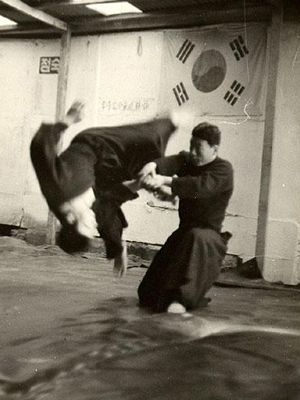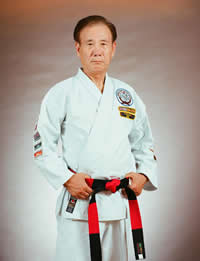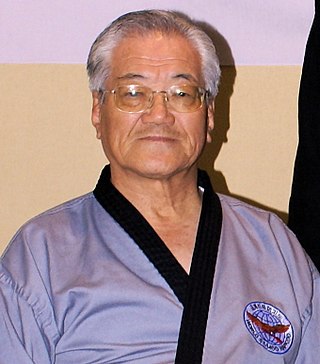
Taekwondo is a Korean martial art and combat sport involving punching and kicking techniques. The word Taekwondo can be translated as tae,kwon,and do. In addition to its five tenets of courtesy,integrity,perseverance,self-control and indomitable spirit,the sport requires three physical skills:poomsae (품새),kyorugi (겨루기) and gyeokpa (격파).

Hapkido is a Korean martial art. It is a form of self-defense that employs joint locks,grappling,throwing techniques,kicks,punches,and other striking attacks. It also teaches the use of traditional weapons,including knife,sword,rope,nunchaku,cane,short stick,and middle-length staff,gun,and bō(Japanese),which vary in emphasis depending on the particular tradition examined.

Jae-chul Shin was a Korean martial artist and founder of the World Tang Soo Do Association.

The Korea Hapkido Federation is the largest,wholly hapkido,governing body for the Korean martial art of hapkido in the world. It is made up of predominantly Korean born students and instructors or those individuals who have directly trained in South Korea. This organization is based in Seoul,South Korea and its president is Oh Se-Lim.

Tang Soo Do is a Korean martial art based on karate and can include fighting principles from taekkyeon,subak,as well as northern Chinese martial arts. From its beginnings in 1944 to today,Tang Soo Do is used by some Kwans to identify the traditional Korean fusion of fighting styles. In the mid 1950s,it became the basis for the martial art taekwondo when the Korean Nine Kwans united.

Ji Han-jae is a South Korean hapkido grandmaster known as the founder of Sin Moo Hapkido. He appeared in the 1972 film Game of Death starring Bruce Lee.

Choi Yong-sool,alternative spelling Choi Yong-sul,was the founder of the martial art Hapkido. He was born in today's North Chungcheong Province,South Korea and was taken to Japan during the Japanese occupation of Korea when he was eight years old. Choi later stated that he became a student of Takeda Sōkaku,and studied a form of jujutsu known as Daitō-ryūAiki-jūjutsu (大東流合気柔術) while in Japan. Choi returned to Korea after the end of World War II and in 1948 began teaching his art at a brewery owned by the father of his first student Seo Bok-seob. He first called his art "Yu Sul (유술)" or "Yawara " later changing it to "Yu Kwon Sool " and "Hap Ki Yu Kwon Sool " and eventually Hapkido.
Han Bong-soo,also known as Bong-soo Han, was a Korean martial artist,author,and the founder of the International Hapkido Federation. He was one of the foremost and recognized practitioners of hapkido through his participation in books,magazine articles,and popular films featuring the martial art. He is often referred to as the "Father of Hapkido" in America.

Korea Taekwondo Association,originally the Korea Tang Soo Do Association (1961),is the first taekwondo organisation. It was founded in 1959,[a] although official South Korean sources give 1961 as its year of establishment.[b] In 1966,some members of the KTA,led by H. H. Choi,broke off from the KTA and formed the International Taekwon-Do Federation (ITF). The Kukkiwon and the then-World Taekwondo Federation were created by the KTA in the early 1970s. The KTA sits under the Korea Sports Council,is aligned with Kukkiwon,and is a Member National Association (MNA) of the WT. Its goal is to promote the martial art taekwondo as a national sport within South Korea.
Hankido (Korean: 한기도) is a new martial art style developed by Myung Jae-nam using circular flowing movements owing to Myung Jae-nam's background in traditional Korean dance.
Chung Do Kwan,created by Won Kuk Lee in 1944,is one of the first of nine schools or kwan teaching Tang Soo Do. Later,the school began to teach what came to be known as taekwondo. This style of Tang Soo Do is known for its overall power and emphasis on kicks to the head.

The International H.K.D. Federation (I.H.F.) was founded in 1974 by hapkido grandmaster Myung Jae Nam. Its original name was the International Hapkido Federation —it was changed when hankido and hankumdo were added to the I.H.F.'s curriculum.
Kwon Tae-man was an early Korean hapkido practitioner and a pioneer of the art,first in Korea and then in the United States. He formed one of the earliest dojang's for hapkido in the United States in Torrance,California,and has been featured in many magazine articles promoting the art.
Kim Moo-hong was one of the earliest students of Korean hapkido under the founder of the art Choi Yong-sool. He was a pioneer of the art opening one of the first schools for the art in Seoul. A great innovator he is credited with having helped develop the kicking system used in most hapkido schools today. He formed one of the earliest Korean organizations for the art,the Korean Hapkido Association.

Combat Hapkido is an eclectic modern Hapkido system founded by John Pellegrini in 1990. Taking the next step in 1992 Pellegrini formed the International Combat Hapkido Federation (ICHF) as the official governing body of Combat Hapkido. Later,in 1999,the ICHF was recognized by the Korea Kido Association and the World Kido Federation,collectively known as the Kido Hae,as the Hapkido style Chon Tu Kwan Hapkido. The World Kido Federation is recognized by the Government of South Korea as an organization that serves as a link between the official Martial Arts governing body of Korea and the rest of the world Martial Arts community. The founder of Combat Hapkido was very clear in his statement that he did not invent a new martial art. He stated "I have merely structured a new Self-Defense system based upon sound scientific principles and modern concepts. For this reason Combat Hapkido is also referred to as the "Science of Self-Defense". Combat Hapkido is a new interpretation and application of a selected body of Hapkido techniques. The word "Combat" was added to Combat Hapkido to distinguish this system from Traditional Hapkido styles and to identify its focus as Self-Defense.
Kim Pyung-soo,also known as Kim Soo,is a South Korean taekwondo practitioner.
American Tang Soo Do is a hybrid martial art brought to the US by Shin Jae Chul who was sent to Springfield,NJ by Hwang Kee in the mid-60’s. Tang Soo Do combined the Korean martial art of Tang Soo Do with Japanese styles of Judo,Shito-ryu Karate and Shotokan Karate. Over the years it has been further developed by former black belts of his and their students.

Sun-hwan Chung,also known as James Sun-hwan Chung,is one of the highest-ranking Tang Soo Do,Hapkido,and taekwondo grandmasters in the world. He is founder of the Moo Sool Do form of martial arts and is president of the World Academy of Martial Arts,LLC.
Kim Yun-sik is a South Korean hapkido and taekwondo instructor. He was born in Seoul,Korea in 1943. He is one of the highest ranking hapkido and taekwondo instructors in the world and founder of Bum Moo Kwan Hapkido.

Sundo - also known as Kouk Sun Do (국선도) - is a Korean Taoist art based on meditation,and which aims at the personal development of its practitioners,both at the physical,mental and spiritual levels.
TaeKwon-Do Times Magazine, Cover / History Feature with Ji, Han Jae, November 2013












